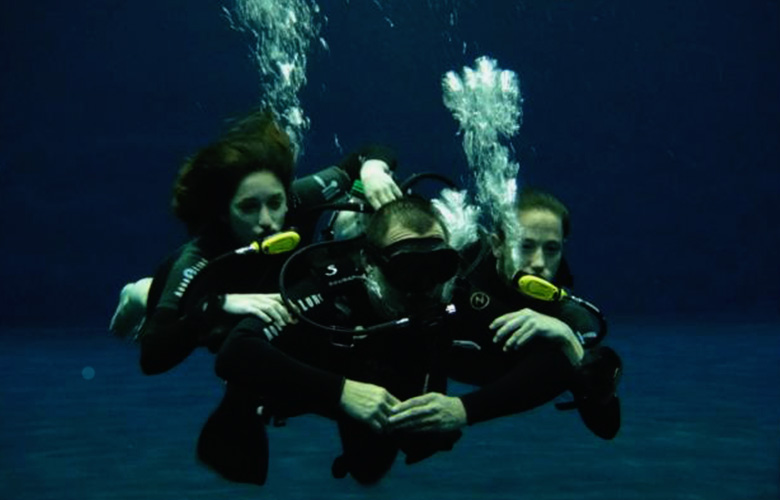
When I tell people about my work as a show diver at The House of Dancing Water in Macau, they are always intrigued. Naturally, they want to know more about it and begin asking questions.
“So, you worked in an underwater zoo?”
“Did you feed the animals?”
“You mean jumping dolphins and stuff like that?”
“What do you mean, acrobats?”
“Do they do all their stunts underwater?”
“In a theatre?”
“Is the audience underwater, too, or are they watching from behind glass windows?”
This is usually the point when I sigh deeply to myself, give up, take out my cell phone or tablet, go on YouTube, and begin showing Making Offs and show sequences.
First of all, no animals are present in these shows. And, don’t worry, as a member of the audience you won’t have to dive underneath the water’s surface. When you walk into these venues, you will see a theatre in the round. The stage will look like a miniature ocean. The water surface will ripple with promises of what is to come. There might be theatrical lighting in the depths of the pool, transforming this unique stage into a mystical pond, a doorway to another dimension.
Most likely, however, the creator of this particular extravaganza will want to keep you in suspense as to what lies beneath. Thus, as you get seated in the auditorium, you will see a mesmerizing darkness, strangely alive and breathing. And, like a child about to open a Christmas present in opulent packaging, your heart will beat faster in expectation of what the creators of this show had in mind for your entertainment. Your senses will pick up the higher levels of humidity in the air, and the scent of fresh water, treated mildly with chlorine and other chemicals to ensure health standards are consistently met for everyone working in this theater.
The pool will be larger than you imagine. At The House of Dancing Water we are talking five million gallons of water, a pool diameter of fifty meters, and a pool depth of ten meters.
During the show, twenty show divers are present in the depths of this gigantic aquatic space, taking care of artists and props alike, while cavernous ceilings loom over their heads, and colossal lifts are moving up and down.
These lifts cause surging currents underneath them, whilst creating dry spaces on an ever-changing stage… landscapes for the audience to visually travel through.
During the show, artists and props magically appear on stage and disappear again underwater. Water jets and geysers shoot in the air, rain falls, thunder rolls, and the ocean shrinks and expands in tune with the artistic vision that lies at the heart of it all.
Not many theatrical aquatics shows exist yet. The first one was O by Cirque du Soleil, in 1998 – enchanting and, after 20 years, still running strong in Las Vegas. This was followed by Le Reve, also in Las Vegas, then The House of Dancing Water in Macau, The Han Show in Wuhan, etc. The artistic endeavor of including the magical presence of water in a theatrical, acrobatics show continued with the opening of La Perle, in Dubai, in September 2017.
People’s overall confusion is forgivable, considering that worldwide there are only a few hundred professional divers who work in theatrical shows. Even more forgivable if I think of a few years back when I was sent an offer from one of the biggest aquatics shows on Earth, The Han Show, in Wuhan, China. At a loss as to how to describe the job of a show diver, their HR department researched online, and ended up sending Florida’s Sea World’s job description for divers and animal caretakers to me during their recruiting process.
To my surprise and amusement, I read that one of the key requirements for getting hired as a show diver for the Han Show was to be “comfortable handling, preparing, and feeding fish.”
If I had to sum up my work as a show diver in one sentence I would say, I am a stage hand, stage manager, coach, and life guard all rolled up into one. Imagine all you already know about working backstage. Then simply add water. An aquatics theatre has an extra layer of backstage added on to it. We make sure this added layer is taken care of, properly managed, coordinated, and kept safe for all cast and crew. As one of the Las Vegas veterans of this unique profession used to say during my training,
“As soon as someone dips a toe into the water, you’re on duty. People are out of their element. They rely on you to keep them safe.”
As I mentioned before, part of our diverse set of responsibilities is to be an instructor and coach. As new artists and scuba divers join the show, we train them in all that is necessary to be safe in and under water. This involves swimming and scuba lessons, plus, most importantly, training the performers in the special techniques used for them to travel underwater along handrails or on a scuba diver’s back, in full costume, to reach their positions.
They learn how to magically appear on stage, gently breaking the surface as they rise from the depths. They also learn how to leap into the water after an act, disappear underneath the surface without so much as a ripple, to then find an air source and mask so they can reach their next position safely without the audience ever being the wiser. Some techniques involve the performers being caught by a diver as they exit the stage into the water. Teamwork and trust between performers and scuba divers are essential in this. Often performers will enter the water out of breath. They will be blind because they do not wear a mask. They will reach out, trusting us to be there, to catch them, and to bring them safely to the other backstage, out of the water.
During training and rehearsals, show divers are lifeguards. They will be in the water, strategically placed at the edge of the pool, in full gear, ready to pounce and rescue should anyone have a bad landing on the water’s surface. For example, during training for acts like Russian Swing and high diving… anything involving performers entering the water from great height. Or, for example, during trapeze training when someone could fall at any time, passing out or possibly even breaking bones.
In an aquatics show, water is the safety net and solid ground, danger and salvation, all at the same time.
During shows, the pool is divided into sections, and the aquatics team takes turns being divided into stage hands and stage managers. Part of our team sets and strikes props, as well as bringing performers to their cue positions for each act. At The House of Dancing Water, we are split into four groups of four divers. Each of these groups is assigned a fifth diver: the dive com. This extra diver is the underwater stage manager.
He or she will be wearing a full-face mask with a direct radio connection to the control booth. Each dive com will coordinate his or her track, making sure all divers and performers are in the right place at the right time. A camera will be mounted on his or her helmet, so the aquatics show caller in the stage management booth isn’t blind as to what is happening underneath the water surface.
We are the guardians of these artificially created oceans. Multi-talents of the deep. Protectors of all who enter the dark indoor seas.
Even though we carry heavy equipment, fight wild currents, and sometimes carry up to two performers on our backs to their positions center stage, you will never see any of us. We are carefully hidden by lighting effects, and millions of bubbles, called masking. In this sea of bubbles, we zip along, each efficient fin stroke propelling us one step further to guarantee a spellbinding theatrical performance on stage, unlike anything you’ve ever experienced before.
Read Life Of A Show Diver: Part 1


Liam Klenk was born in Central Europe and has since lived on four continents. Liam has always been engaged in creative pursuits, ranging from photography and graphic design, to writing short stories and poetry, to working in theatre and shows. In 2016, Liam published his first book and memoir, 'Paralian'.
Read Full Profile© 2021 TheatreArtLife. All rights reserved.

Thank you so much for reading, but you have now reached your free article limit for this month.
Our contributors are currently writing more articles for you to enjoy.
To keep reading, all you have to do is become a subscriber and then you can read unlimited articles anytime.
Your investment will help us continue to ignite connections across the globe in live entertainment and build this community for industry professionals.